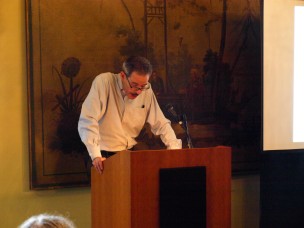
Quinnipiac University Law Professor Neal Feigenson gave a talk on the use of subjective evidence in trials earlier this week as part of the Center for the Humanities (CHUM) lecture series. The lecture, which was entitled “What It’s Like: Demonstrative Evidence of Subjective States,” discussed how subjective experience can be presented as evidence in a court of law.
“Without the demonstrative, we’re in the position of those who heard medieval travelers’ stories about distant cultures,” Feigenson said. “We have no way of confidently separating embellishment from truth. Here there be sounds, but we can’t really know what they are. With demonstrative [evidence], we believe that we can [know what is true]. We always knew there was something there, and now we know what it is. Subjective experience becomes that much more of a fact.”
In his lecture, Feigenson primarily discussed “Dennis Janson v. J.D.O.R.A.P. Inc.,” a personal injuries case that took place March 2011 in Danbury, Conn. Janson sued JDORAP, where he had worked as an acoustic engineer, for giving him tinnitus. This is a condition in which a person hears a buzzing in their ear when no sound is made.
During the trial, Janson’s attorney asked an audiologist to produce a loud buzzing noise, which they argued was comparable to Janson’s symptoms, to the court. Feigenson played the same recording of the noise during the lecture.
“We can’t be sure at all that we’re hearing what he hears,” Feigenson said. “Even if we could we still wouldn’t know what it’s really like for him to hear the same sound because we can’t hear anything close to the totality of what he hears.”
Feigenson continued to discuss the difficulties of presenting personal experience as evidence in a court of law. He examined two different cases in which subjective experience was presented as demonstrative fact using new types of technology. While never supporting or opposing such methods in court, Feigenson was sure that this would continue.
“I can’t believe that there won’t be many lawyers who wouldn’t try to introduce [evidence like this],” Feigenson said. “For all I know, a lot of them have, and I just don’t know about it. The prospect of being able to convey to a jury, not just with words but with what purports to be the actual experience of what’s going on inside someone’s head just seems to me to be such a powerful form of evidence that if you can get it in, why wouldn’t you try?”
Feigenson was the third of twelve scheduled speakers for the CHUM Fall 2011 lecture series entitled Fact and Artifact. More than 50 students, professors, and alumni attended the lecture. Feigenson also spoke at the CHUM Colloquium, which took place on Sept. 27.
“I thought the lecture was extraordinary,” said CHUM Director and Psychology Professor Jill Morawski. “His use of cases of demonstrative evidence and how subjective experience is being rendered as evidence through new technologies got to the center of our questions of what counts as fact and how the recipients of those facts have changed in response to these new technologies.”
Feigenson’s lecture also appears to have impressed some of the student audience.
“I definitely feel humbled,” said Pierre Gerard ’15. “I’ve learned something beyond me, something that I can carry into my years here. For now, I feel like I’ve seen into a career that talks a lot about law and the subjective versus the objective, and those are key ideas for everyone in college.”


Leave a Reply